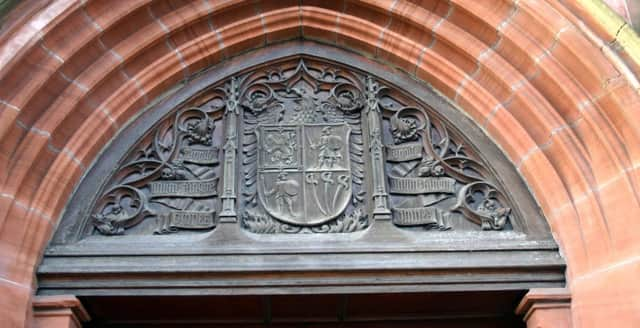Flagging up communities' heritage in coat of arms


Barra, Shetland, Caithness and Orkney are examples which call up ancient connections with Scandinavia at a time when folk feel remote from power centres in Edinburgh and London.
As last week’s Herald article reminded us, Denny is the first town in Scotland to adopt a flag which, in Councillor Paul Garner’s words, “is part of our identity and we are proud of it”.
Advertisement
Hide AdAdvertisement
Hide AdIt is unlikely to be the last and I wouldn’t be surprised to see other communities getting out the coloured crayons and digging into their local history. Of course it is nothing new.
Falkirk Council has a coat-of-arms which serves much the same purpose, made up of elements of the arms of the former independent burghs of Grangemouth, Bo’ness, Denny and Falkirk itself.
An early version of the Grangemouth arms was in use in the 1880s but the officially approved one is from 1920.
It combines two historical references: The stag’s head with a cross is the symbol of Holyrood and is a reminder of the foundation of the abbey by King David I as a thanksgiving for avoiding death on the antlers of a stag.
Advertisement
Hide AdAdvertisement
Hide AdThe abbots of Holyrood were the early overlords of much of the land that became Grangemouth hence all the ‘‘abbot’’ names in the area.
The other element is the Charlotte Dundas, the world’s first practical steamboat, built in Grangemouth in 1803. The motto Ingenium Vincit Omnes meaning genius (or talent) overcomes all difficulties is quite appropriate for a modern industrial town.
As one might expect, the former Bo’ness arms also feature a sailing ship representing the basis of the town’s prosperity.
The black half of the background stands for the coal mining industry and the red half, along with the coronet and the lion, are for the powerful Hamilton family.
Advertisement
Hide AdAdvertisement
Hide AdThe arms were approved in 1930 and have a Latin motto Sine Metu which means ‘‘Fear Nothing’’ which is also the family motto of Jameson’s Irish whiskey and appears on every bottle!
The Denny and Dunipace arms are the most recent, dating back to 1956.
They bear more than a passing resemblance to the new flag with the ‘‘angel of peace’’ representing Dunipace above a bridge with the Carron flowing below. The motto is ‘‘For God and the People’’.
The original arms of Falkirk which emerged sometime in the 18th century can still be found on display in the town.
Advertisement
Hide AdAdvertisement
Hide AdFor example high up on the Glebe Street elevation of the old Burgh Buildings is a caved panel dating to 1880 and there is another wooden carving above the door of the library in Hope Street. Unlike the other towns, Falkirk’s story is confused. Early versions seem to derive from the arms of the Livingstons with the blocks or ‘‘billets’’ representing the original Callendar family.
These arms had two ‘‘savages’’ with clubs acting as ‘‘supporters’’ on either side of the shield which later versions had converted into young boys.
The figures on the Burgh Buildings are in that form.
There were also references to the meeting of Highlands and Lowlands as well as our familiar motto Tangite Unam, Tangite Omnes.
In 1906 the official version was approved and the supporters were gone leaving the Livingston lion with symbols representing Callendar, the two Falkirk battles, the parish church and the Antonine Wall. The motto, by now in English, declares ‘‘Touch Ane, Touch A’, Better Meddle wi’ the Deil than the Bairns o‘ Fa’kirk’’. It should be above the main entrance to the Falkirk Stadium.